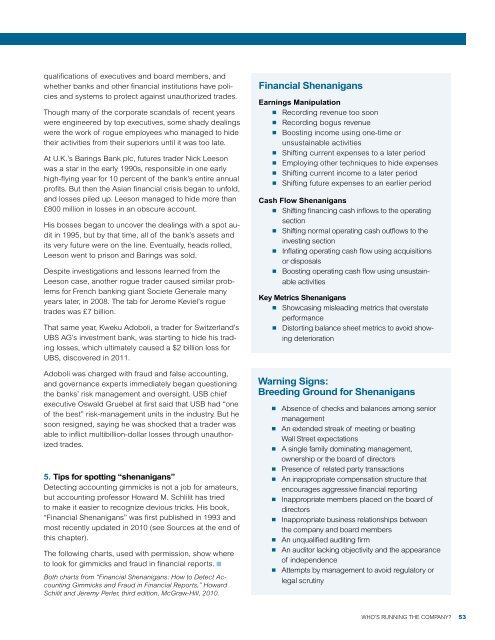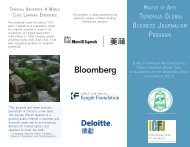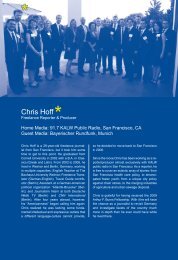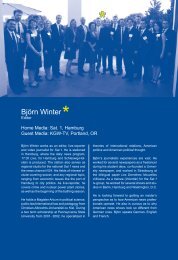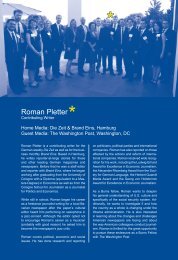Who's Running the Company? - International Center for Journalists
Who's Running the Company? - International Center for Journalists
Who's Running the Company? - International Center for Journalists
Create successful ePaper yourself
Turn your PDF publications into a flip-book with our unique Google optimized e-Paper software.
qualifications of executives and board members, and<br />
whe<strong>the</strong>r banks and o<strong>the</strong>r financial institutions have policies<br />
and systems to protect against unauthorized trades.<br />
Though many of <strong>the</strong> corporate scandals of recent years<br />
were engineered by top executives, some shady dealings<br />
were <strong>the</strong> work of rogue employees who managed to hide<br />
<strong>the</strong>ir activities from <strong>the</strong>ir superiors until it was too late.<br />
At U.K.’s Barings Bank plc, futures trader Nick Leeson<br />
was a star in <strong>the</strong> early 1990s, responsible in one early<br />
high-flying year <strong>for</strong> 10 percent of <strong>the</strong> bank’s entire annual<br />
profits. But <strong>the</strong>n <strong>the</strong> Asian financial crisis began to unfold,<br />
and losses piled up. Leeson managed to hide more than<br />
£800 million in losses in an obscure account.<br />
His bosses began to uncover <strong>the</strong> dealings with a spot audit<br />
in 1995, but by that time, all of <strong>the</strong> bank’s assets and<br />
its very future were on <strong>the</strong> line. Eventually, heads rolled,<br />
Leeson went to prison and Barings was sold.<br />
Despite investigations and lessons learned from <strong>the</strong><br />
Leeson case, ano<strong>the</strong>r rogue trader caused similar problems<br />
<strong>for</strong> French banking giant Societe Generale many<br />
years later, in 2008. The tab <strong>for</strong> Jerome Keviel’s rogue<br />
trades was £7 billion.<br />
That same year, Kweku Adoboli, a trader <strong>for</strong> Switzerland’s<br />
UBS AG’s investment bank, was starting to hide his trading<br />
losses, which ultimately caused a $2 billion loss <strong>for</strong><br />
UBS, discovered in 2011.<br />
Adoboli was charged with fraud and false accounting,<br />
and governance experts immediately began questioning<br />
<strong>the</strong> banks’ risk management and oversight. USB chief<br />
executive Oswald Gruebel at first said that USB had “one<br />
of <strong>the</strong> best” risk-management units in <strong>the</strong> industry. But he<br />
soon resigned, saying he was shocked that a trader was<br />
able to inflict multibillion-dollar losses through unauthorized<br />
trades.<br />
5. Tips <strong>for</strong> spotting “shenanigans”<br />
Detecting accounting gimmicks is not a job <strong>for</strong> amateurs,<br />
but accounting professor Howard M. Schlilit has tried<br />
to make it easier to recognize devious tricks. His book,<br />
“Financial Shenanigans” was first published in 1993 and<br />
most recently updated in 2010 (see Sources at <strong>the</strong> end of<br />
this chapter).<br />
The following charts, used with permission, show where<br />
to look <strong>for</strong> gimmicks and fraud in financial reports. n<br />
Both charts from “Financial Shenanigans: How to Detect Accounting<br />
Gimmicks and Fraud in Financial Reports,” Howard<br />
Schilit and Jeremy Perler, third edition, McGraw-Hill, 2010.<br />
Financial Shenanigans<br />
Earnings Manipulation<br />
n Recording revenue too soon<br />
n Recording bogus revenue<br />
n Boosting income using one-time or<br />
unsustainable activities<br />
n Shifting current expenses to a later period<br />
n Employing o<strong>the</strong>r techniques to hide expenses<br />
n Shifting current income to a later period<br />
n Shifting future expenses to an earlier period<br />
Cash Flow Shenanigans<br />
n Shifting financing cash inflows to <strong>the</strong> operating<br />
section<br />
n Shifting normal operating cash outflows to <strong>the</strong><br />
investing section<br />
n Inflating operating cash flow using acquisitions<br />
or disposals<br />
n Boosting operating cash flow using unsustainable<br />
activities<br />
Key Metrics Shenanigans<br />
n Showcasing misleading metrics that overstate<br />
per<strong>for</strong>mance<br />
n Distorting balance sheet metrics to avoid showing<br />
deterioration<br />
Warning Signs:<br />
Breeding Ground <strong>for</strong> Shenanigans<br />
n Absence of checks and balances among senior<br />
management<br />
n An extended streak of meeting or beating<br />
Wall Street expectations<br />
n A single family dominating management,<br />
ownership or <strong>the</strong> board of directors<br />
n Presence of related party transactions<br />
n An inappropriate compensation structure that<br />
encourages aggressive financial reporting<br />
n Inappropriate members placed on <strong>the</strong> board of<br />
directors<br />
n Inappropriate business relationships between<br />
<strong>the</strong> company and board members<br />
n An unqualified auditing firm<br />
n An auditor lacking objectivity and <strong>the</strong> appearance<br />
of independence<br />
n Attempts by management to avoid regulatory or<br />
legal scrutiny<br />
WHO’S RUNNING THE COMPANY?<br />
53


